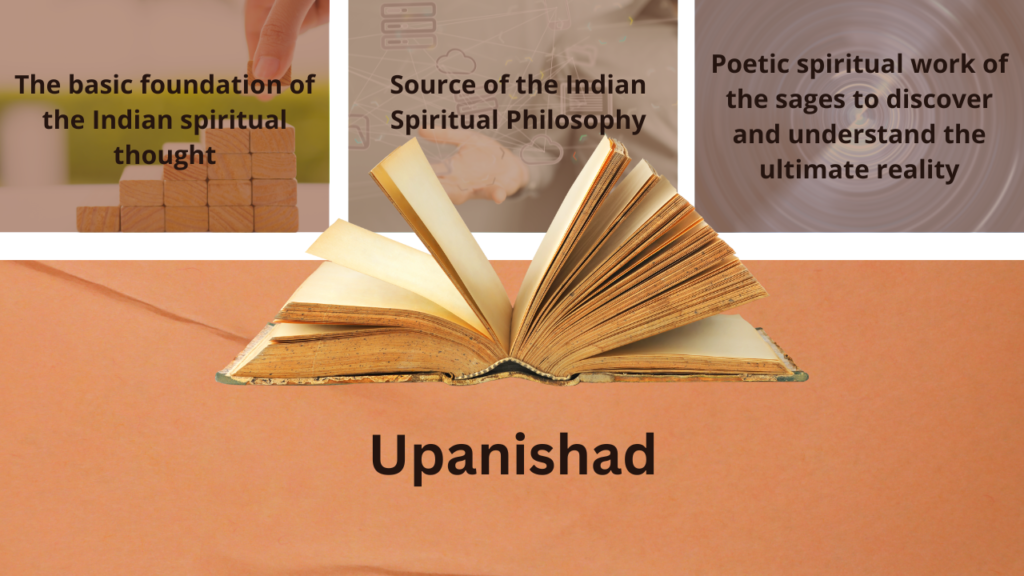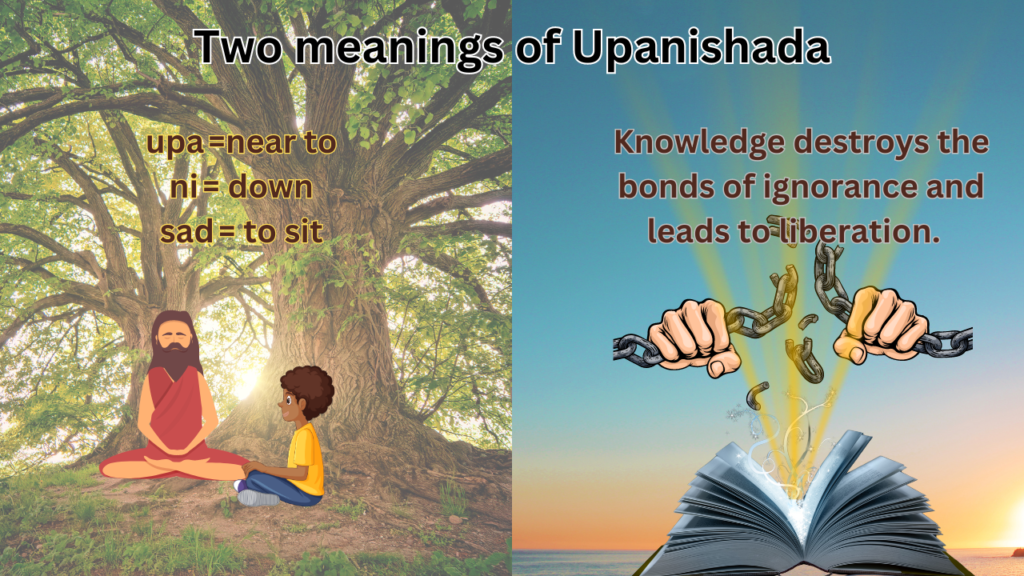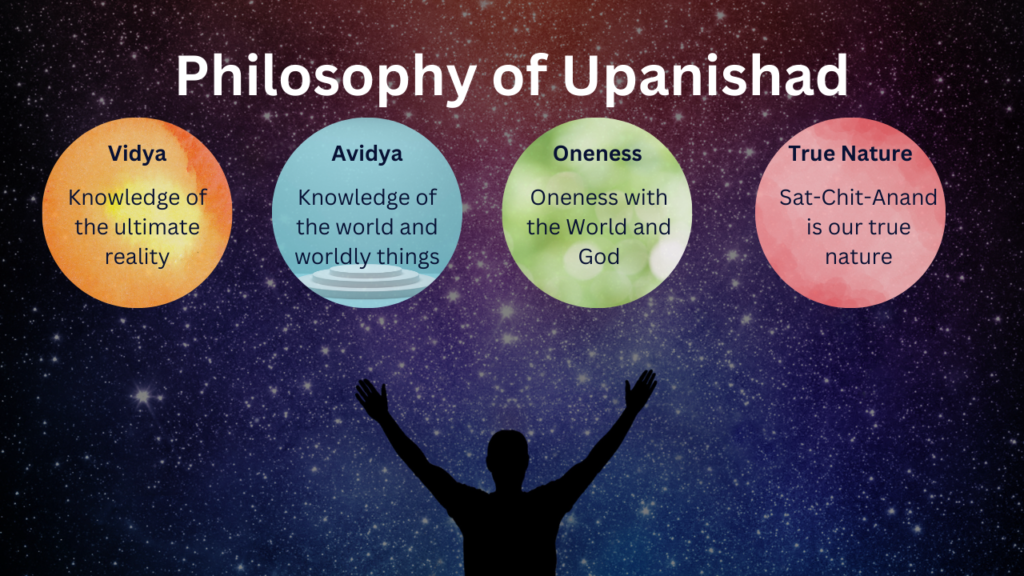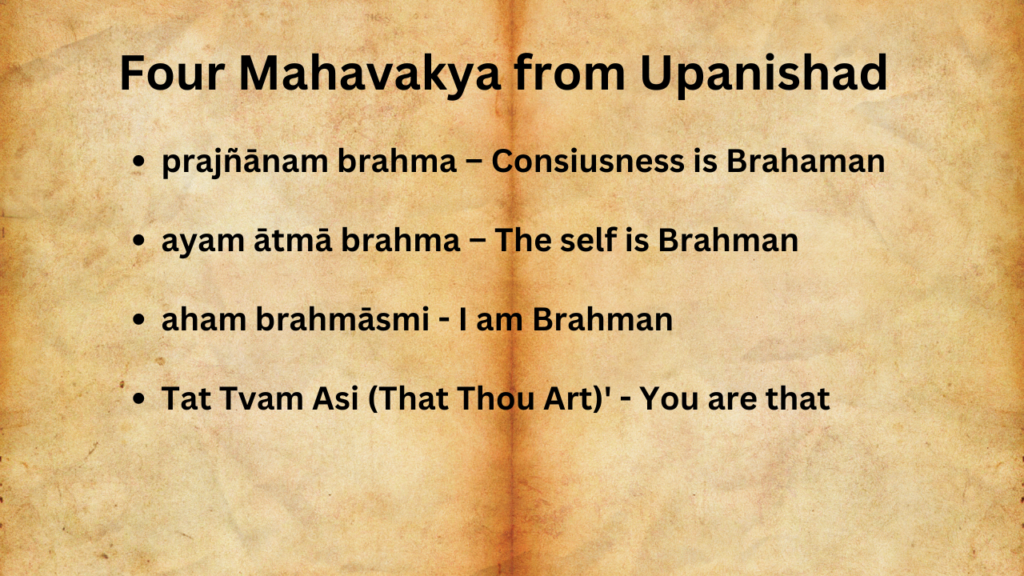
What is Upanishad?
Upanishads are the basic foundation of the Indian spiritual thought and the source of the Indian Spiritual Philosophy. They are the poetic spiritual work of the sages to discover and understand the ultimate reality. Upanishad mainly contains the dialogs between Guru and Shishya.
The meaning of the word Upanishad

Upanishad has two different meanings.
1. According to the first, Upanishad (upa+ni+sad) means sitting near or down.
Since the knowledge was taught to students who sat near the master, at a lower level or his feet, while the master sat on a higher seat (asana), his teaching was called Upanishad. Here the word near also means Upanishad knowledge is not to all the students has to be qualified to learn it.
2. According to the second interpretation Upanishad means the knowledge destroys the bonds of ignorance and leads to liberation.
Why is Upanishad called Vedanta?
Upanishad marks the concluding part of the Vedas and also means the culmination of the Vedic thought.
Subjects of the Upanishads

The subject of the Upanishad is highly philosophical. The Hindi meaning of Philosophy is Darshana. To find the ultimate unchanging reality from the ever-changing world around us is the main subject of the Upanishads. They talk about the two main entities Brahman and Atman.
Brahman
In Sanskrit, Brahman is defined as satyam jnanam anantam brahma, which can be translated as “that which never changes,” “knowledge,” and “infinity.”
The word Brahman is derived from the Sanskrit root “brh”, meaning “to grow or expand.” Brahman is understood to be both that which grows and that which causes other things to grow. It is the omnipresent and eternal source of all that exists in the universe, and it is therefore present in everything; every person, every molecule, and every atom.
Atman
Atman is a Sanskrit word, defined in simple terms as an individual’s inner self, spirit, or soul. It is regarded as eternal and imperishable, distinct from the physical body, mind, and consciousness. It is believed to be found in every living being, though we do not realize it because of ignorance.
Philosophy of Upanishad

Two types of Vidyas
Hindi meaning of the word Philosophy is Darshan, How we see this world, feel about it, and put it.
To answer this question Upanishad suggests two types of Vidyas(knowledge).
Avidya
Avidya means the knowledge of the world and worldly things. It helps us fulfill the responsibilities and obligations that we have towards family, society, or the world.
Vidya
Vidya means knowledge of the ultimate reality through which this world exists. It helps further on the spiritual path.
So Upanishad tells us to focus of both Vidya and Avidya and work towards making progress on both.
Oneness with the God
The Upanishads are not telling us about any God. Then, what are they telling us? They are speaking about God, but not about the God that we usually think in our mind according to our upbringing, culture, language or tradition. They talk about the one ultimate reality Brahman and our oneness with Brahman. The Chandogya Upanishad says ‘Tatvamasi’ means you are that. You are that reality and nothing else.
Sat-Chit-Anand is our true nature
We are conscious of the existence of our Self, though that consciousness is covered and we are not aware of it directly, because of the cover of Maya(ignorance). we are consciousness. What kind of consciousness? Consciousness of something? Because when we say “I am conscious”, we always mean conscious of this world.
Mandukya Upanishad gives an answer to this with an example of a deep sleep state. In deep sleep, we are not conscious about ourselves and the world. It is the consciousness of Being only—just Awareness of the fact of your existence. In Sanskrit, we call this Consciousness chit, and the consciousness of Being is chit-sat or sat-chit. Were we happy in deep sleep? Yes, we were. All life’s pains disappear and vanish, even significant agony, sickness, or any other discomfort is nullified during deep sleep, rejuvenating us. We feel happy when you wake up. So we were existing, we were conscious, we were happy. Existence-Consciousness-Bliss was your real nature.
How many Upanishads are there?
Total 108 Upanishads are available, out of them only 10 are considered the principal Upanishads because Adi Guru Shankaracharya has written commentary on them. They are Isha, Kena and Katha, Prashan, Mundaka, Mandukya, Tattiriya, Aitareya, Chhandogya and Brihadaranyaka.
Teachings of 10 principal Upannishad

1. Isha Upanishad
Isha Upanishad teaches us that divine presence is everywhere. We have to balance between worldly life and spiritual practice and detachment while living in this world and fulfilling our duties.
2. Kena Upanishad
Kena Upanishad points out the one and ultimate source, through which our all senses are working. It is also the source of our existence and our intelligence and realizing this source is the goal of our life. This urges people to go beyond just knowing things in their heads and instead discover their true selves through direct experience.
3. Katha Upanishad
Katha Upanishad sheds light on the eternal nature of the soul. We have to seek spiritual knowledge to escape the cycle of life and death and find true freedom.
4. Prashna Upanishad
The Prashna Upanishad discusses creation and the importance of knowing oneself. It explains the meaning behind six questions asked by seekers, helping to understand the Self better.
5. Mundaka Upanishad
Mundaka Upanishad tells us about the importance of the Guru in the path of knowledge. It tells us about the 2 types of Vidyas. Vidya is about the worldly things called apara vidya and Vidya is about the supreme reality called para vidya.
6. Mandukya Upanishad
Mandukya Upanishad tells us about the syllable OM. It also talks about the four states of consciousness 1. waking 2. dreaming 3 deep sleep and 4. Turiya (state of the ultimate consciousness)
The mahavakya “ayam ātmā brahma” – The self is Brahman is from this Upanishad.
7. Tattiriya Upanishad
Tattiriya Upanishad talks about the 5 layers of existence (Panchkosha). From the outermost to the innermost layer of bliss, the last layer is our true nature, and realizing it is the goal of our life.
It also teaches us to do the right thing, showing respect to teachers, and fulfilling social duties.
8. Aitareya Upanishad
Aitareya Upanishad shed light on the creation of the Universe and the interconnection between all things. This highlights that the Self is eternal and that the world is an illusion.
The mahavakya prajñānam brahma – Consiusness is Brahaman is from this Upanishad.
9. Chhandogya Upanishad
A central teaching of this Upanishad is that you are the ultimate reality.
The famous mahavakya “Tat Tvam Asi (That Thou Art)’ – You are that“ is from this Upanishad. The Upanishad looks into Brahman’s nature, stressing deep thinking and meditation.
10. Brihadaranyaka Upanishad
Brihadaranyaka Upanishad looks into things like what’s real, how individuals relate to the bigger picture, and why self-control matters in spiritual growth.
The mahavakya aham brahmāsmi – I am Brahman is from this Upanishad.

